

This Computer Uses Light—Not Electricity—To Train AI Algorithms. Tree of Life : Exhibits : Yale Peabody Museum of Natural History. Reconstructing the Tree of Life One key issue in reconstructing the Tree of Life is the development of algorithms and computational infrastructure to allow scientists around the world to apply the same methods.
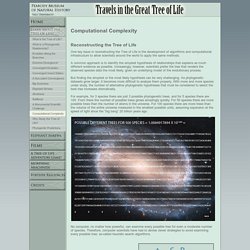
A common approach is to identify the simplest hypothesis of relationships that explains as much different evidence as possible. Increasingly, however, scientists prefer the tree that renders the observed species data the most likely, given an underlying model of the evolutionary process. But finding the simplest or the most likely hypothesis can be very challenging. As phylogenetic datasets grow larger, it becomes more difficult to analyze them properly.
For example, for 3 species there are just 3 possible phylogenetic trees, and for 5 species there are 105. No computer, no matter how powerful, can examine every possible tree for even a moderate number of species. One method quickly builds a starting tree and then rapidly swaps branches around to find better trees. Genetic programming. In artificial intelligence, genetic programming (GP) is a technique whereby computer programs are encoded as a set of genes that are then modified (evolved) using an evolutionary algorithm (often a genetic algorithm - "GA").
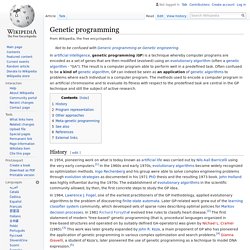
The result is a computer program able to perform well in a predefined task. Often confused to be a kind of genetic algorithm, GP can indeed be seen as an application of genetic algorithms to problems where each individual is a computer program. The methods used to encode a computer program in an artificial chromosome and to evaluate its fitness with respect to the predefined task are central in the GP technique and still the subject of active research. History[edit] In 1954, pioneering work on what is today known as artificial life was carried out by Nils Aall Barricelli using the very early computers.[1] In the 1960s and early 1970s, evolutionary algorithms became widely recognized as optimization methods. In 1964, Lawrence J. Program representation[edit] [edit] New Algorithms Force Scientists to Revise the Tree of Life. When the British morphologist St.
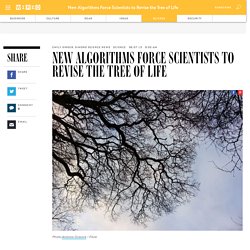
George Jackson Mivart published one of the first evolutionary trees in 1865, he had very little to go on. He built the tree — a delicately branching map of different primate species — using detailed analysis of the animals’ spinal columns. But a second tree, generated by comparing the animals’ limbs, predicted different relationships among the primates, highlighting a challenge in evolutionary biology that continues to this day.
Algorithm. Flow chart of an algorithm (Euclid's algorithm) for calculating the greatest common divisor (g.c.d.) of two numbers a and b in locations named A and B.
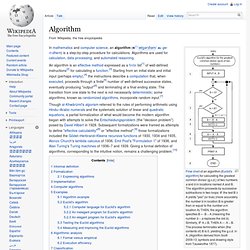
The algorithm proceeds by successive subtractions in two loops: IF the test B ≥ A yields "yes" (or true) (more accurately the numberb in location B is greater than or equal to the numbera in location A) THEN, the algorithm specifies B ← B − A (meaning the number b − a replaces the old b). Similarly, IF A > B, THEN A ← A − B. The process terminates when (the contents of) B is 0, yielding the g.c.d. in A. (Algorithm derived from Scott 2009:13; symbols and drawing style from Tausworthe 1977). In mathematics and computer science, an algorithm ( Computer science. Computer science deals with the theoretical foundations of information and computation, together with practical techniques for the implementation and application of these foundations History[edit] The earliest foundations of what would become computer science predate the invention of the modern digital computer.
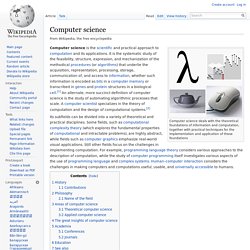
An improved general E-unification method. Bachmair, 1987 L.

BachmairProof Methods for Equational Theories dissertation, U. of Illinois, Urbana-Champaign (1987) Bachmair et al., 1986 L. Proc. Bachmair et al., 1987. E-unification. Previous: Equational term rewrite systems Next: Quasi-identity logic Up: Supplementary Text Topics Just as unification plays a crucial role in the study of term rewrite systems (see Chapter III of LMCS), one has E-unification for work with ETRS's.
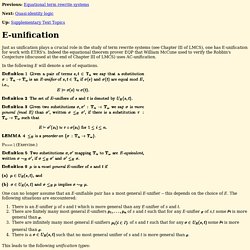
Indeed the equational theorem prover EQP that William McCune used to verify the Robbin's Conjecture (discussed at the end of Chapter III of LMCS) uses AC-unification. E-unification. A fast parallel algorithm for N-ary unification with AI applications. Unification is the central primitive used in all Resolution based Automated Theorem Proving systems (Robinson65a) and Logic Programming (Kowalski74) environments.
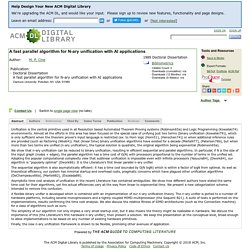
Almost all the efforts in this area has been focused on the special case of unifying just two terms (binary unification (Kowalski79)), which is only sufficient when the theorem prover's input language is restricted (ex: to Horn logic (Horn51), (Henschen74)) or when additional inference rules are provided (such as Factoring (Wos64)). Fast (linear time) binary unification algorithms have existed for a decade (Martelli77), (Paterson78b), but when more than two terms are unified (n-ary unification), the typical solution is quadratic, the original algorithm being exponential (Robinson65a). We show that n-ary unification can be reduced to binary unification, resulting in efficient sequential and parallel algorithms. Unification. Unification or unification theory may refer to: Computer science[edit] Physics[edit] Grand Unified Theory, a model in particle physicsUnified field theory, a type of field theory Politics[edit]
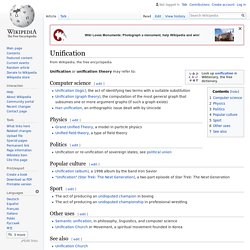
Scientists discover how to turn light into matter after 80-year quest. Imperial College London physicists have discovered how to create matter from light - a feat thought impossible when the idea was first theorised 80 years ago.
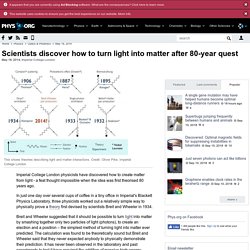
In just one day over several cups of coffee in a tiny office in Imperial's Blackett Physics Laboratory, three physicists worked out a relatively simple way to physically prove a theory first devised by scientists Breit and Wheeler in 1934. Breit and Wheeler suggested that it should be possible to turn light into matter by smashing together only two particles of light (photons), to create an electron and a positron – the simplest method of turning light into matter ever predicted. The calculation was found to be theoretically sound but Breit and Wheeler said that they never expected anybody to physically demonstrate their prediction. What's going on: Turning sound into light (article) Light into sound introduction. René Descartes - Academic, Philosopher, Mathematician, Scientist - Biography. Philosopher and mathematician René Descartes is regarded as the father of modern philosophy for defining a starting point for existence, “I think; therefore I am.” Synopsis René Descartes was born on March 31, 1596, in La Haye en Touraine, France.
He was extensively educated, first at a Jesuit college at age 8, then earning a law degree at 22, but an influential teacher set him on a course to apply mathematics and logic to understanding the natural world. Descartes' Life and Works. 1. Early Years Descartes was born in La Haye on March 31, 1596 of Joachim Descartes and Jeanne Brochard. He was one of a number of surviving children (two siblings and two half-siblings). His father was a lawyer and magistrate, which apparently left little time for family. Descartes’ mother died in May of the year following his birth, and he, his full brother and sister, Pierre and Jeanne, were left to be raised by their grandmother in La Haye. In search of the brain of Descartes. Descartes and the Pineal Gland.
1. File:Descartes. Diagram of the brain and nerves Wellcome L0017000.jpg. Kinetic energy. In classical mechanics, the kinetic energy of a non-rotating object of mass m traveling at a speed v is . In relativistic mechanics, this is a good approximation only when v is much less than the speed of light. The standard unit of kinetic energy is the joule. History and etymology[edit] The adjective kinetic has its roots in the Greek word κίνησις kinesis, meaning "motion". The principle in classical mechanics that E ∝ mv² was first developed by Gottfried Leibniz and Johann Bernoulli, who described kinetic energy as the living force, vis viva.
Electromagnetism and gravity dark matter and red shift and blue shift - Recherche Google. Doppler Effect in Light: Red & Blue Shift. Light waves from a moving source experience the Doppler effect to result in either a red shift or blue shift in the light's frequency. This is in a fashion similar (though not identical) to other sorts of waves, such as sound waves. The major difference is that light waves do not require a medium for travel, so the classical application of the Doppler effect doesn't apply precisely to this situation. Time Dilation in Your Living Room - Cosmic Variance : Cosmic Variance. Cosmic variance. The term cosmic variance is the statistical uncertainty inherent in observations of the universe at extreme distances. It has three different but closely related meanings: It is sometimes used, incorrectly, to mean sample variance - the difference between different finite samples of the same parent population. Such differences follow a Poissonian distribution, and in this case the term sample variance should be used instead.It is sometimes used, mainly by cosmologists, to mean the uncertainty because we can only observe one realization of all the possible observable universes.
For example, we can only observe one Cosmic Microwave Background, so the measured positions of the peaks in the Cosmic Microwave Background spectrum, integrated over the visible sky, are limited by the fact that only one spectrum is observable from Earth. Waves, motion and frequency: the Doppler effect. Doppler effect. Waves, motion and frequency: the Doppler effect. Redshift, blue shift, and time dilation - Relativity - Science Forums. New supernova analysis reframes dark energy debate.
Redshift and Distance in the Expanding Universe. Last week, we began talking about understanding the size of the Universe, and we continued this week with some information on distances and motion in the Universe. This brings us to my favorite application, which leads to the Hubble expansion: Redshift. Descarte sand Linear Perspective. Alberti and Brunelleschi, the founders of linear perspective in painting, "made accessible to vision . . . the modern, systematic conception of space, in a concrete artistic sphere even before abstract mathematical science had given form and force to it as a postulate.
"1 Brunelleschi's costruzione legittima, his method of correct or exact perspective, is concerned with representing objects themselves in proper scale and relation to one another. Yet, from the concern for scale, Renaissance painters will develop a geometric space complimentary to the mathematical space of Descartes's philosophy. Cartesianism. Cartesianism is the philosophical and scientific system of René Descartes and its subsequent development by other seventeenth century thinkers, most notably Nicolas Malebranche and Baruch Spinoza.[1] Descartes is often regarded as the first thinker to emphasize the use of reason to develop the natural sciences.[2][citation needed] For him, the philosophy was a thinking system that embodied all knowledge, and expressed it in this way:[3]
Cartesian materialism. Cartesianism. Galileo affair. Blaise pascal descartes attempt to do away with god. Blaise pascal. Galileo in Rome for Inquisition - HISTORY. Galileo is convicted of heresy - HISTORY. Trial of Galileo. The truth about Galileo and his conflict with the Catholic Church. Galileo arrives in Rome for trial before Inquisition. Cartesian coordinate system - Recherche Google. Cartesian coordinate system. Leibniz and lutton - Google-Suche. I think therefore i am descartes - Google-Suche. Cogito, ergo sum. Chapter 7: Knowledge and Learning Descartes. 0704. World. A Map of the Universe, According to René Descartes. Finding Our Place in the Cosmos: From Galileo to Sagan and Beyond
The Clockwork Universe. Descartes: Human Nature. Descartes' Physics. René Descartes. Vortex Theory of René Descartes, the 17th Century French Philosopher and Mathematician! Descartes, Rene. The science and physics theory of Rene Descartes. True-ruler-of-universe-as-is-introduced. Lect_2. From Eric Weisstein's World of Scientific Biography. M.youtube. Www.sparknotes. Scientificrevolution. Www.jstor. Natural philosophy. Mechanism. Corpuscularianism. Atomism. Solar System. Sun. Heliocentrism. Nicolaus Copernicus. Roman Inquisition. Galileo Galilei. Marin Mersenne. Principles of Philosophy. Theories of Light from Descartes to Newton: Physics Today: Vol 36, No 3. Descartes's Theory of Light and Refraction: A Discourse on Method on JSTOR.
Corpuscular theory of light. Speed of light. Mathematical constant. Physical constant. Speed of light. Kinetic energy. What Are Redshift and Blueshift? Effect of Dark Matter and Dark Energy on Gravitation by Ron Kurtus - Physics Lessons: School for Champions. Dark energy acceleration of space effect on red shift. Blueshift. Redshift. What is Redshift? And what is it used for? Space Exploratorium - Doppler Shift. The Universe - Redshifts. Astronomy Essentials. Wtamu. Astrophysics - Redshift of light in dark matter - Physics Stack Exchange. What effect does dark matter have on blue-shifting the light leaving a galaxy's gravity well and how would it affect measurements of expansion?